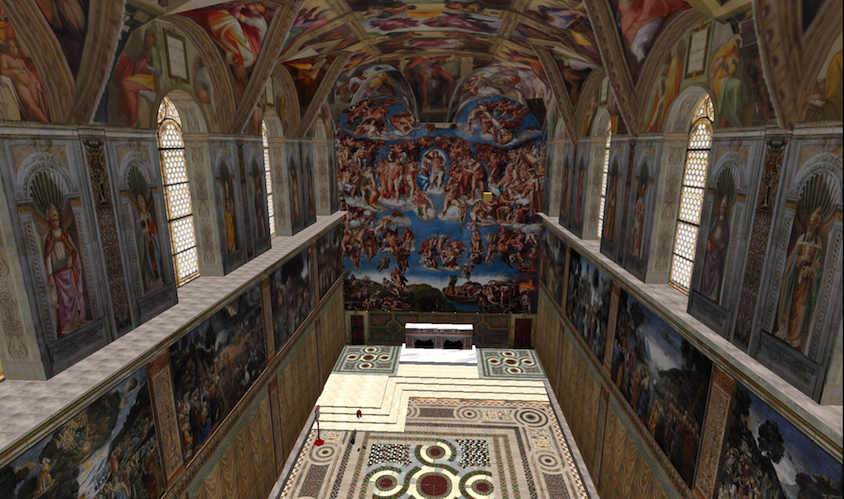Virtually U.
Vassar Second Life build, Sistine Chapel reconstruction
A virtual campus that’s been more extensively developed is owned and operated by Vassar College. I include a review of this build because one of its most famous features, the virtual Sistine Chapel, is a relatively less effective use of Second Life for new media literacy learning, although it is a stunningly beautiful example of what can be done with the virtual world, aesthetically.
If you bring your Second Life avatar here, you can take a tour in a gondola around the grounds and you will be shown all the highlights of the island. Not all of it resembles the actual campus, but nevertheless strives for a realistic rendering. One of the most celebrated parts of the virtual campus is a replication of the Sistine Chapel. From a transcript of an in-world tour posted on YouTube (2007), the tour guide speaks:
This started out as a faculty member talking about how she teaches the art of the Sistine and the concern has always been that not many humans get a chance to see the Sistine Chapel. Steve Taylor...decided to take it upon himself to see if he could recreate the Sistine Chapel. He chose it not only because Jackie taught it but because it's a really simple rectangular building with art that's readily available on the Internet. I mean, the pictures of the Sistine are available everywhere. Over the course of a couple of months, he created the Sistine Chapel. He put it up to show Jackie and show other visual resource librarians what could be done and the response has been absolutely stunning and overwhelming. We have had thousands and thousands of individuals enter the Sistine, it's talked about as one of the top ten places one must see when they enter Second Life, it's been called the killer app for higher ed in Second Life, it's been written up in magazines, it's been written up in chronicles, yet despite all of that it's never been used to teach anybody anything. (Kirkwood SL Group)
I want to draw attention to the statement about this being one of the most widely celebrated attractions in Second Life but one which has never been used to teach anybody anything. (My point here is not to disparage the learning that has taken place on the build, but to note that learning escapes being the focus of this higher ed "app.") If you take the in-world gondola tour around the virtual campus, you will hear a lot about the potential of social activity that will take place in the various buildings, the hope that these will become active meeting places.
Let’s think again about Bolter’s and Grusin’s promise of reform through new media. Here the promise of reform is the promise of a new way of social gathering that will lead to something as good as that which happens in the real Vassar campus. I would at least assume that is the goal; if not as good as, perhaps even better in some way—by facilitating meetings between people who can’t travel to the physical campus, for example. But it’s now 2011 and we’re still hearing about that potential, without much evidence of the activity. You’ll remember what Bolter and Grusin also said about new media, that although it promises the reform of old media into something better, it ultimately draws the attention back to itself as hypermedia. What is perhaps most noteworthy about the virtual campus is not its improvement on the real one as a meeting place, but the fact of its own existence as media, as hypermedia—a fact that is burned into our consciousness every time we visit the virtual campus and underscored by the endless potential referenced in the gondola tour script.

